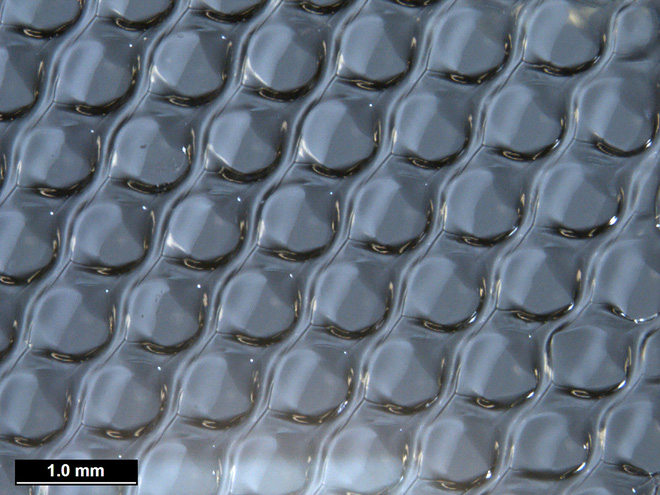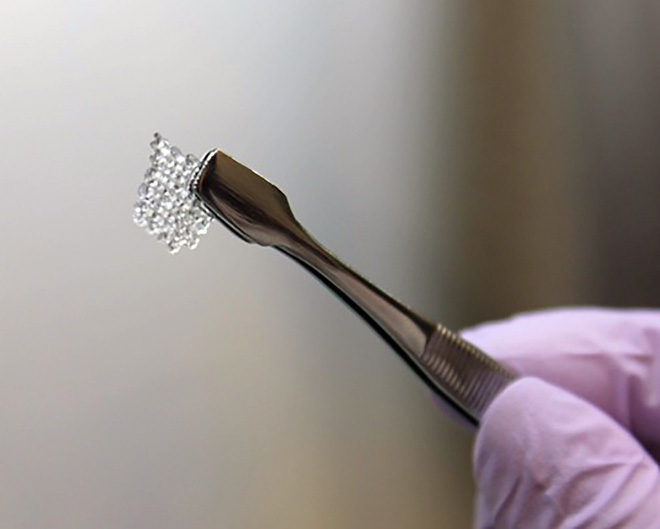3D print ovaries bring hope to mother for many infertile women
Scientists have successfully printed the 3D ovary, after being implanted into infertile mice they had the first perfectly healthy babies. This is said to be an amazing achievement of biotechnology, giving hope to infertile women.
- Find a mathematical formula that determines how a male sperm swimming
- A human can be created from a laboratory, without eggs and sperm
In about 5 years, a 3D printed ovarian version for humans will appear.

The first mice were born by mother mice with 3D ovaries.
The "holy grail" of regenerative medicine
Previously, donor ovarian transplantation was the method used when a woman's ovaries were damaged. But choosing the right donor source is extremely difficult. The best case is when the patient has a twin sister but not any woman who is inferior is so lucky.
Teresa K. Woodruff, a reproductive scientist and colleague at Northwestern University, created artificial ovaries with biological materials and used 3D printers to print them, opening a new direction in treatment of infertility in women.

In the future, 3D human body organs will be used.
The research team had to carefully study the structure of the actual ovary to be able to build a biological ovary.
They had to use chemicals to completely remove the follicles, blood vessels and tissues of a real ovary from the donor to obtain an exposed superstructure that is a very complex and tightly woven collagen frame as shown. a net.
This collagen frame of the ovary can be rebuilt using 3D printing technology. But choosing materials to make ink for printers is a problem. The team decided to use collagen and ovarian tissue as the raw material for artificial ovaries. The broken collagen tissue into gelatin, a porous compound, helps to interact easily with tissue and blood of transplanted organisms and is less likely to be eliminated by the body. At the same time, gelatin is a tougher hydrogel than other hydrogel compounds including up to 99% water and a small fraction of the polymer.

An ovarian structure is printed from Gelatin material.
The researchers found a temperature point of gelatin, which allowed it to retain its structure without clumping, to build up multilayer structures. It is about 30 degrees Celsius, if higher structure will be sagging, lower gelatin will shrink.
After many attempts to print multiple ovarian tissue with different meshes, the researchers found the optimal model to test on the organism.
Will 3D ovaries work?
Scientists use ovaries to 3D print for nine female mice that have been removed from their ovaries to check the activity of this artificial ovary.
The 3 mice out of 7 that were mating gave birth to their first litter and all the pups born were healthy.
Mother mice also have milk, which means their hormonal signals still work well. Before that, the ovulation of female mice lasted every 4 days. Their pregnancy lasts only 20 days and young mice mature within 4 months.

A multi-layer ovarian structure printed by a 3D printer will be implanted in the mouse.
When can this artificial ovary be used for infertile women?
After a successful test on mice, scientists immediately proceeded to print larger ovaries to serve tests on pigs.
If these tests are also successful, human trials will be conducted. First, it will be an ovary that helps restore hormonal function, then proceed to a perfect artificial ovary, which can replace the natural organ of humans.
An ovary that helps restore hormonal function to activate puberty for young female cancer patients whose bodies are destroyed by cancer treatment before puberty may appear as early as 5 years. next.
The artificial ovaries will follow the life of a baby girl, until she matures and natural menopause. If it was modeled correctly, she could become a normal mother like any other woman.
It will be a huge challenge for the team to make artificial 3D ovaries work well. Because in fact, the ovary is an extremely complex organ, in the chain of hormonal signal connections with the brain and only when the vascular system is effective, the ovulation cycle is perfectly simulated. .
But maybe, thanks to the progressive scientific achievements of the future, our children will be able to "print" from within.
You should read it
- Korean research shows a link between male infertility and noisy bedrooms
- To know your biological age, check your urine sample
- The first baby in the world was born from three parents, of which 2 were infertile
- Experience in controlling gout is effective during treatment
- The first human being had a biological pause to extend life, literally 'switched off and on'
- Changing the biological clock makes people more susceptible to infection
- Artificial neurons have been able to communicate with biological neurons via the Internet
- Whoever expected the creature to be 10cm long and only known on this table could change the world
May be interested
- What do women really want?
 what do women really want? it is a puzzle that perhaps comes to the best wisdom house in this world.
what do women really want? it is a puzzle that perhaps comes to the best wisdom house in this world. - 6 facts about women that they themselves must be surprised
 women are full of mysteries and the facts about them can surprise you. find out about interesting statistics about women in the world below.
women are full of mysteries and the facts about them can surprise you. find out about interesting statistics about women in the world below. - Is it safe to use lipstick during pregnancy?
 however, not all types of lipstick are harmful, if using safe lipstick, pregnant mother can still apply lipstick so that she is always beautiful.
however, not all types of lipstick are harmful, if using safe lipstick, pregnant mother can still apply lipstick so that she is always beautiful. - The pregnant woman is anemic and should eat well for her mother and baby
 anemia during pregnancy is a common phenomenon. in addition to iron supplements to help with blood supply, a reasonable diet with natural foods is also an effective solution to improve this situation. so what do pregnant mothers need to eat? with quantrimang go find an answer!
anemia during pregnancy is a common phenomenon. in addition to iron supplements to help with blood supply, a reasonable diet with natural foods is also an effective solution to improve this situation. so what do pregnant mothers need to eat? with quantrimang go find an answer! - 8/3 poems or for mothers, wives and lovers
 the poems of 8/3 are happy, good, meaning for the mother, wife, and girlfriends that we have summarized below will be extremely meaningful spiritual gifts for dear women.
the poems of 8/3 are happy, good, meaning for the mother, wife, and girlfriends that we have summarized below will be extremely meaningful spiritual gifts for dear women. - The first baby in the world was born from three parents, of which 2 were infertile
 on january 5 last, the baby had three parents of the first infertile couple in the world born in ukraine.
on january 5 last, the baby had three parents of the first infertile couple in the world born in ukraine. - What gifts for your wife on International Women's Day 8/3?
 international women's day 8/3 is coming soon. do you still hesitate to choose a gift to give to your beloved wife on this holiday?
international women's day 8/3 is coming soon. do you still hesitate to choose a gift to give to your beloved wife on this holiday? - Men who want to succeed stay away from these seven types of women
 women are flowers, are women. but the perfect choice for eyebrows, probably should not have 7 types of women below.
women are flowers, are women. but the perfect choice for eyebrows, probably should not have 7 types of women below. - 7 features to help women become more attractive
 the following 7 features help women leave a deep and more attractive impression on men. admittedly, the children in each of us often want to be curious about the magic formula supposedly to bring double benefits.
the following 7 features help women leave a deep and more attractive impression on men. admittedly, the children in each of us often want to be curious about the magic formula supposedly to bring double benefits. - Relax with 3 ways to print in this simple reverse order
 there is always a right way to print your documents. some inkjet printers print pages from the top, which means you have to manually reverse the print order. this is not a problem when printing only a few pages, but when you print a few hundred pages of documents then you need a trick to print them in reverse order so you can arrange them neatly.
there is always a right way to print your documents. some inkjet printers print pages from the top, which means you have to manually reverse the print order. this is not a problem when printing only a few pages, but when you print a few hundred pages of documents then you need a trick to print them in reverse order so you can arrange them neatly.










 Find a mathematical formula that determines how a male sperm swimming
Find a mathematical formula that determines how a male sperm swimming Sperm also has a 'switch' that helps to turn on and off
Sperm also has a 'switch' that helps to turn on and off Light can trick the immune system to attack cancer
Light can trick the immune system to attack cancer Researchers found new antibodies to kill cancer cells
Researchers found new antibodies to kill cancer cells Warning: Complications from thyroid cancer surgery are increasing
Warning: Complications from thyroid cancer surgery are increasing Science successfully created 3D lung models with the size and characteristics of true lungs
Science successfully created 3D lung models with the size and characteristics of true lungs